what term is used to describe the price that hotels pay for insurance?


A typical hotel room with a bed, desk, and television

A hotel is an establishment that provides paid lodging on a short-term basis. Facilities provided inside a hotel room may range from a minor-quality mattress in a small room to large suites with bigger, higher-quality beds, a dresser, a refrigerator and other kitchen facilities, upholstered chairs, a flat screen television set, and en-suite bathrooms. Small, lower-priced hotels may offer only the most bones invitee services and facilities. Larger, higher-priced hotels may provide boosted guest facilities such equally a swimming pool, business organisation centre (with computers, printers, and other function equipment), childcare, conference and outcome facilities, tennis or basketball game courts, gymnasium, restaurants, twenty-four hour period spa, and social function services. Hotel rooms are normally numbered (or named in some smaller hotels and B&Bs) to allow guests to identify their room. Some boutique, high-end hotels take custom decorated rooms. Some hotels offer meals as part of a room and lath organisation. In Japan, capsule hotels provide a tiny room suitable only for sleeping and shared bathroom facilities.
The precursor to the modern hotel was the inn of medieval Europe. For a period of virtually 200 years from the mid-17th century, coaching inns served as a place for lodging for coach travelers. Inns began to cater to richer clients in the mid-18th century. I of the starting time hotels in a modern sense was opened in Exeter in 1768. Hotels proliferated throughout Western Europe and North America in the early on 19th century, and luxury hotels began to jump upward in the later part of the 19th century.
Hotel operations vary in size, function, complexity, and cost. Nigh hotels and major hospitality companies have set industry standards to classify hotel types. An upscale full-service hotel facility offers luxury civilities, full-service accommodations, an on-site restaurant, and the highest level of personalized service, such equally a concierge, room service, and dress pressing staff. Full-service hotels often contain upscale full-service facilities with many full-service accommodations, an on-site full-service eating place, and a multifariousness of on-site civilities. Bazaar hotels are smaller independent, not-branded hotels that often incorporate upscale facilities. Pocket-size to medium-sized hotel establishments offer a limited amount of on-site amenities. Economy hotels are small to medium-sized hotel establishments that offering bones accommodations with little to no services. Extended stay hotels are small to medium-sized hotels that offering longer-term full-service accommodations compared to a traditional hotel.
Timeshare and destination clubs are a class of property ownership involving ownership of an individual unit of accommodation for seasonal usage. A motel is a pocket-size-sized low-rise lodging with direct access to individual rooms from the car park. Bazaar hotels are typically hotels with a unique environs or intimate setting. A number of hotels take entered the public consciousness through popular culture, such as the Ritz Hotel in London. Some hotels are built specifically as destinations in themselves, for case casinos and holiday resorts.
Most hotel establishments are run by a general director who serves as the head executive (often referred to equally the "hotel managing director"), department heads who oversee diverse departments inside a hotel (e.g., food service), middle managers, administrative staff, and line-level supervisors. The organizational chart and volume of job positions and hierarchy varies past hotel size, office and class, and is often determined past hotel ownership and managing companies.
Etymology
The word hotel is derived from the French hôtel (coming from the aforementioned origin every bit hospital), which referred to a French version of a edifice seeing frequent visitors, and providing care, rather than a place offering accommodation. In contemporary French usage, hôtel now has the aforementioned meaning as the English term, and hôtel particulier is used for the quondam meaning, likewise as "hôtel" in some identify names such every bit Hôtel-Dieu (in Paris), which has been a infirmary since the Eye Ages. The French spelling, with the circumflex, was also used in English, but is now rare. The circumflex replaces the 's' found in the earlier hostel spelling, which over fourth dimension took on a new, but closely related meaning. Grammatically, hotels unremarkably have the definite commodity – hence "The Astoria Hotel" or just "The Astoria."
History
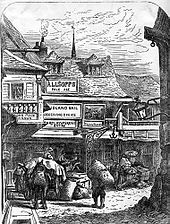
Facilities offer hospitality to travellers featured in early civilizations. In Greco-Roman culture and in ancient Persia, hospitals for recuperation and remainder were built at thermal baths. Guinness Earth Records officially recognised Japan's Nishiyama Onsen Keiunkan, founded in 705, as the oldest hotel in the world.[1] During the Middle Ages, various religious orders at monasteries and abbeys would offer accommodation for travellers on the road.
The forerunner to the mod hotel was the inn of medieval Europe, possibly dating back to the dominion of Aboriginal Rome. These would provide for the needs of travellers, including food[two] and lodging, stabling and fodder for the traveller'south horses and fresh horses for mail service coaches. Famous London examples of inns include the George and the Tabard. A typical layout of an inn featured an inner court with bedrooms on the ii sides, with the kitchen and parlour at the front and the stables at the back.[3]
For a period of well-nigh 200 years from the mid-17th century, coaching inns served as a place for lodging for coach travellers (in other words, a roadhouse). Coaching inns stabled teams of horses for stagecoaches and mail service coaches and replaced tired teams with fresh teams. Traditionally they were seven miles apart, but this depended very much on the terrain.
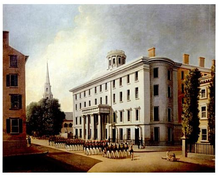
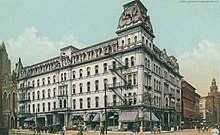
The Boody House Hotel in Toledo, Ohio
Some English language towns had as many every bit ten such inns and rivalry between them became intense, not only for the income from the stagecoach operators but for the revenue from the food and potable supplied to the wealthy passengers. By the end of the century, coaching inns were being run more professionally, with a regular timetable being followed and stock-still menus for nutrient.[4]
Inns began to cater to richer clients in the mid-18th century, and consequently grew in grandeur and in the level of service provided. Sudhir Andrews traces "the birth of an organised hotel industry" to Europe's chalets and small hotels which catered primarily to aristocrats.[5] One of the first hotels in a modern sense, the Royal Clarence, opened in Exeter in 1768, although the idea but really defenseless on in the early-19th century. In 1812 Mivart's Hotel opened its doors in London, afterward changing its proper name to Claridge's.[6]
Hotels proliferated throughout Western Europe and North America in the 19th century. Luxury hotels, including the 1829 Tremont House in Boston, the 1836 Astor House in New York Metropolis,[7] the 1889 Savoy Hotel in London, and the Ritz chain of hotels in London and Paris in the late 1890s, catered to an always more-wealthy clientele.
International scale
Hotels cater to travelers from many countries and languages, since no one country dominates the travel industry.
| Land | Hotel rooms in 2011–12[8] [nine] | Average rooms per hotel[nine] | Overnight tourists traveling from each country, annual[viii] [9] |
|---|---|---|---|
| U.s. | 4,900,000 | 93 | 58,000,000 |
| China | 1,500,000 | 132 | 83,000,000 |
| Japan | 1,370,000 | 27 | xviii,000,000 |
| Italy | i,100,000 | 32 | 29,000,000 |
| Germany | 950,000 | 27 | 72,000,000 |
| Kingdom of spain | 900,000 | 47 | 12,000,000 |
| Mexico | 660,000 | 37 | 16,000,000 |
| United Kingdom | 650,000 | 17 | 57,000,000 |
| French republic | 620,000 | 36 | 26,000,000 |
| Thailand | 530,000 | NA | 6,000,000 |
| Indonesia | 410,000 | 25 | 7,000,000 |
| Hellenic republic | 400,000 | 41 | 5,000,000 |
| Brazil | 400,000 | 40 | 8,000,000 |
| Turkey | 330,000 | 117 | 16,000,000 |
| Republic of austria | 290,000 | 22 | 11,000,000 |
| Russian federation | 260,000 | 33 | 44,000,000 |
| Global full | 21,000,000 | 41 | 876,000,000 |
Types
Hotel operations vary in size, function, and cost. Most hotels and major hospitality companies that operate hotels have set up widely accustomed industry standards to classify hotel types. Full general categories include the following:
International luxury



International luxury hotels offer high-quality amenities, total-service accommodations, on-site full-service restaurants, and the highest level of personalized and professional service in major or capital cities. International luxury hotels are classified with at to the lowest degree a Five Diamond rating or Five Star hotel rating depending on the state and local classification standards. Example brands include: Yard Hyatt, Conrad, InterContinental, Sofitel, Mandarin Oriental, Four Seasons, The Peninsula, Rosewood, JW Marriott and The Ritz-Carlton.
Lifestyle luxury resorts



Lifestyle luxury resorts are branded hotels that appeal to a invitee with lifestyle or personal image in specific locations. They are typically full-service and classified as luxury. A key characteristic of lifestyle resorts is focus on providing a unique guest experience every bit opposed to simply providing lodging. Lifestyle luxury resorts are classified with a Five Star hotel rating depending on the country and local nomenclature standards. Example brands include: Waldorf Astoria, St. Regis, Shangri-La, Oberoi, Belmond, Jumeirah, Aman, Taj Hotels, Hoshino, Raffles, Fairmont, Banyan Tree, Regent and Park Hyatt.
Upscale full-service
Upscale full-service hotels oft provide a wide array of guest services and on-site facilities. Ordinarily constitute amenities may include: on-site food and beverage (room service and restaurants), coming together and conference services and facilities, fettle center, and business organisation center. Upscale full-service hotels range in quality from upscale to luxury. This classification is based upon the quality of facilities and amenities offered by the hotel.[10] Examples include: Westward Hotels, Sheraton, Langham, Kempinski, Kimpton Hotels, Hilton, Lotte, Renaissance, Marriott and Hyatt Regency brands.
Boutique
Boutique hotels are smaller independent not-branded hotels that oft comprise mid-scale to upscale facilities of varying size in unique or intimate settings with total-service accommodations. These hotels are more often than not 100 rooms or fewer.[11]
Focused or select service
Small-scale to medium-sized hotel establishments that offer a limited number of on-site amenities that only cater and marketplace to a specific demographic of travelers, such as the unmarried business traveler. Nearly focused or select service hotels may still offer total-service accommodations but may lack leisure amenities such as an on-site eatery or a pond pool. Examples include Hyatt Place, Holiday Inn, Courtyard by Marriott and Hilton Garden Inn.
Economic system and limited service
Small to medium-sized hotel establishments that offer a very limited number of on-site amenities and oft but offering basic accommodations with little to no services, these facilities normally only cater and market to a specific demographic of travelers, such as the budget-minded traveler seeking a "no frills" accommodation. Limited service hotels often lack an on-site eating house but in render may offering a limited free nutrient and drink assiduities such as on-site continental breakfast service. Examples include Ibis Budget, Hampton Inn, Aloft, Holiday Inn Express, Fairfield Inn, and Four Points by Sheraton.
Extended stay
Extended stay hotels are pocket-sized to medium-sized hotels that offer longer-term full-service accommodations compared to a traditional hotel. Extended stay hotels may offer non-traditional pricing methods such equally a weekly rate that caters towards travelers in need of brusk-term accommodations for an extended period of fourth dimension. Similar to limited and select service hotels, on-site civilities are normally limited and most extended stay hotels lack an on-site restaurant. Examples include Staybridge Suites, Candlewood Suites, Homewood Suites by Hilton, Home2 Suites by Hilton, Residence Inn by Marriott, Element, and Extended Stay America.
Timeshare and destination clubs are a form of property ownership also referred to equally a vacation buying involving the purchase and ownership of an individual unit of accommodation for seasonal usage during a specified period of fourth dimension. Timeshare resorts oft offer amenities like that of a full-service hotel with on-site restaurants, swimming pools, recreation grounds, and other leisure-oriented amenities. Destination clubs on the other mitt may offer more sectional individual accommodations such as private houses in a neighborhood-style setting. Examples of timeshare brands include Hilton K Vacations, Marriott Vacation Gild International, Westgate Resorts, Disney Vacation Gild, and Holiday Inn Club Vacations.
Motel
A cabin, an abbreviation for "motor hotel", is a small-sized low-rise lodging establishment similar to a limited service, lower-price hotel, only typically with direct admission to individual rooms from the motorcar park. Motels were congenital to serve route travellers, including travellers on road trip vacations and workers who drive for their job (travelling salespeople, truck drivers, etc.). Common during the 1950s and 1960s, motels were often located adjacent to a major highway, where they were congenital on inexpensive country at the border of towns or along stretches of freeway.
New cabin construction is rare in the 2000s as hotel bondage have been building economy-priced, limited-service franchised properties at motorway exits which compete for largely the same clientele, largely saturating the market by the 1990s. Motels are still useful in less populated areas for driving travelers, but the more than populated an area becomes, the more than hotels move in to run across the demand for accommodation. While many motels are unbranded and independent, many of the other motels which remain in performance joined national franchise bondage, often rebranding themselves as hotels, inns or lodges. Some examples of chains with motels include EconoLodge, Motel 6, Super viii, and Travelodge.
Motels in some parts of the globe are more ofttimes regarded every bit places for romantic assignations where rooms are oft rented by the hour. This is fairly common in parts of Latin America.
Microstay
Hotels may offer rooms for microstays,[12] a type of booking for less than 24 hours where the customer chooses the check in time and the length of the stay. This allows the hotel increased acquirement by reselling the aforementioned room several times a day.[13]
Direction
Hotel management is a globally accepted professional person career field and bookish field of study. Degree programs such as hospitality management studies, a business caste, and/or certification programs formally prepare hotel managers for industry practice.
Nigh hotel establishments consist of a general director who serves equally the head executive (oftentimes referred to as the "hotel manager"), department heads who oversee various departments within a hotel, middle managers, administrative staff, and line-level supervisors. The organizational chart and volume of job positions and hierarchy varies past hotel size, office, and is often determined by hotel ownership and managing companies.
Unique and specialty hotels
Historic inns and boutique hotels


G Hotel Viljandi at wintertime in Viljandi, Estonia
Boutique hotels are typically hotels with a unique environs or intimate setting. Some hotels take gained their renown through tradition, by hosting significant events or persons, such as Schloss Cecilienhof in Potsdam, Deutschland, which derives its fame from the Potsdam Conference of the World War II allies Winston Churchill, Harry Truman and Joseph Stalin in 1945.[fourteen] The Taj Mahal Palace & Tower in Mumbai is ane of India's virtually famous and historic hotels considering of its association with the Indian independence motility. Some establishments take given name to a particular meal or drinkable, as is the case with the Waldorf Astoria in New York City, United States where the Waldorf Salad was starting time created or the Hotel Sacher in Vienna, Austria, abode of the Sachertorte. Others accept achieved fame by association with dishes or cocktails created on their premises, such as the Hotel de Paris where the crêpe Suzette was invented or the Raffles Hotel in Singapore, where the Singapore Sling cocktail was devised.[xv]
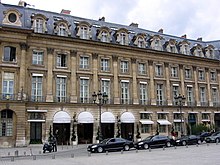
A number of hotels have entered the public consciousness through pop civilization, such as the Ritz Hotel in London, through its association with Irving Berlin's song, 'Puttin' on the Ritz'. The Algonquin Hotel in New York City is famed every bit the meeting identify of the literary grouping, the Algonquin Round Tabular array, and Hotel Chelsea, too in New York City, has been the subject of a number of songs and the scene of the stabbing of Nancy Spungen (allegedly by her boyfriend Sid Vicious).
Resort hotels


Some hotels are built specifically as a destination in itself to create a captive trade, example at casinos, amusement parks and holiday resorts. Though hotels have always been built in popular destinations, the defining feature of a resort hotel is that it exists purely to serve another attraction, the ii having the same owners.
On the Las Vegas Strip in that location is a tradition of one-upmanship with luxurious and extravagant hotels in a concentrated expanse. This tendency now has extended to other resorts worldwide, merely the concentration in Las Vegas is still the earth'south highest: nineteen of the earth's twenty-five largest hotels by room count are on the Strip, with a total of over 67,000 rooms.[16]
Other speciality hotels

- The Burj al-Arab hotel in Dubai, United Arab Emirates, built on an artificial isle, is structured in the shape of a boat's canvass.
- The Library Hotel in New York Metropolis, is unique in that each of its 10 floors is assigned i category from the Dewey Decimal System.
- The Jailhotel Löwengraben in Lucerne, Switzerland is a converted prison at present used as a hotel.
- The Luxor, a hotel and casino on the Las Vegas Strip in Paradise, Nevada, United States is unusual due to its pyramidal structure.
- The Liberty Hotel in Boston used to be the Charles Street Jail.
- Hotel Kakslauttanen in Finland, a drove of glass igloos in Lapland that allow y'all to sentinel the Northern Lights[17]
- Built in Scotland and completed in 1936, The quondam ocean liner RMSQueen Mary in Long Beach, California, Us uses its get-go-class staterooms as a hotel, after retiring in 1967 from Transatlantic service.
- The Wigwam Motels used patented novelty architecture in which each motel room was a free-standing concrete wigwam or teepee.

Railroad Park Resort, a Caboose Hotel in Northern California
- Various Caboose Motel or Red Caboose Inn properties are built from decommissioned track cars.
- Throughout the world there are several hotels congenital from converted airliners.
Bunker hotels
The Nix Stern Hotel in Teufen, Appenzellerland, Switzerland and the Concrete Mushrooms in Albania[18] are sometime nuclear bunkers transformed into hotels.
Cavern hotels
The Cuevas Pedro Antonio de Alarcón (named after the author) in Guadix, Kingdom of spain, too as several hotels in Cappadocia, Turkey, are notable for being congenital into natural cave formations, some with rooms underground. The Desert Cavern Hotel in Coober Pedy, South Australia is built into the remains of an opal mine.
Cliff hotels

On superlative of the cliff, the Riosol Hotel in Mogán
Located on the coast but loftier above body of water level, these hotels offering unobstructed panoramic views and a peachy sense of privacy without the feeling of total isolation. Some examples from around the globe are the Riosol Hotel in Gran Canaria, Caruso Belvedere Hotel in Amalfi Coast (Italian republic), Aman Resorts Amankila in Bali, Birkenhead Firm in Hermanus (S Africa), The Caves in Jamaica and Caesar Augustus in Capri.[19]
Capsule hotels
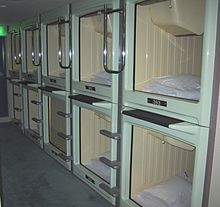
Capsule hotels are a type of economical hotel beginning introduced in Japan, where people slumber in stacks of rectangular containers.
Solar day room hotels
Some hotels make full daytime occupancy with twenty-four hours rooms, for case, Rodeway Inn and Suites nigh Port Everglades in Fort Lauderdale, Florida.[twenty] Day rooms are booked in a cake of hours typically between 8 am and 5 pm,[21] before the typical dark shift. These are similar to transit hotels in that they appeal to travelers, however, dissimilar transit hotels, they do non eliminate the demand to go through Customs.
Garden hotels
Garden hotels, famous for their gardens before they became hotels, include Gravetye Manor, the domicile of garden designer William Robinson, and Cliveden, designed past Charles Barry with a rose garden by Geoffrey Jellicoe.
Ice, snow and igloo hotels
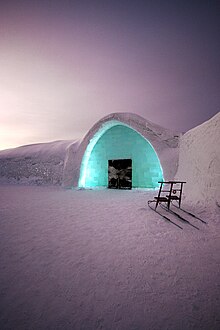
Ice Hotel in Jukkasjärvi, Sweden
The Ice Hotel in Jukkasjärvi, Sweden, was the first water ice hotel in the world; first built in 1990, it is built each winter and melts every jump. The Hotel de Glace in Duschenay, Canada, opened in 2001 and it'south North America'due south only water ice hotel. It is redesigned and rebuilt in its entirety every yr. Ice hotels can also be included within larger ice complexes; for instance, the Mammut Snow Hotel in Republic of finland is located within the walls of the Kemi snow castle; and the Lainio Snow Hotel is office of a snow village almost Ylläs, Republic of finland. There is an arctic snowhotel in Rovaniemi in Lapland, Finland, along with glass igloos.[22] The starting time glass igloos were built in 1999 in Finland, they became the Kakslauttanen Arctic Resort with 65 buildings, 53 small ones for 2 people and 12 large ones for four people. Drinking glass igloos, with their roof made of thermal drinking glass, let guests to admire auroras comfortably from their beds.[23]
Love hotels
A beloved hotel (likewise 'love cabin', especially in Taiwan) is a type of brusk-stay hotel institute effectually the world, operated primarily for the purpose of allowing guests privacy for sexual activities, typically for 1 to three hours, but with overnight as an option. Styles of premises vary from extremely low-stop to extravagantly appointed. In Nihon, love hotels have a history of over 400 years.[24]
Referral hotel
A referral hotel is a hotel chain that offers branding to independently operated hotels; the chain itself is founded by or owned by the member hotels as a group. Many former referral chains have been converted to franchises; the largest surviving member-owned chain is Best Western.
Railway hotels
The first recorded purpose-congenital railway hotel was the Great Western Hotel, which opened adjacent to Reading railway station in 1844, shortly after the Slap-up Western Railway opened its line from London. The building withal exists, and although information technology has been used for other purposes over the years, it is now again a hotel and a member of the Malmaison hotel chain.[25] [26] [27]
Ofttimes, expanding railway companies built grand hotels at their termini, such as the Midland Hotel, Manchester next to the former Manchester Primal Station, and in London the ones to a higher place St Pancras railway station and Charing Cross railway station. London likewise has the Chiltern Court Hotel above Baker Street tube station, at that place are also Canada'southward thousand railway hotels. They are or were more often than not, merely not exclusively, used past those traveling by rail.
Straw bale hotels
The Maya Guesthouse in Nax Mont-Noble in the Swiss Alps, is the beginning hotel in Europe built entirely with harbinger bales. Due to the insulation values of the walls information technology needs no conventional heating or ac system, although the Maya Guesthouse is built at an altitude of 1,300 metres (4,300 ft) in the Alps.[28]
Transit hotels
Transit hotels are brusk stay hotels typically used at international airports where passengers can stay while waiting to change airplanes. The hotels are typically on the airside and do non crave a visa for a stay or re-admission through security checkpoints.
Treehouse hotels
Some hotels are congenital with living trees as structural elements, for example the Treehotel well-nigh Piteå, Sweden, the Costa Rica Tree Business firm well-nigh the Jairo Mora Sandoval Gandoca-Manzanillo Mixed Wild fauna Refuge, Costa rica; the Treetops Hotel in Aberdare National Park, Republic of kenya; the Ariau Towers near Manaus, Brazil, on the Rio Negro in the Amazon; and Bayram'south Tree Houses in Olympos, Turkey.
Underwater hotels
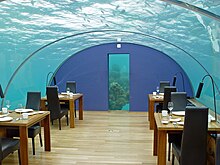
Some hotels have adaptation underwater, such every bit Utter Inn in Lake Mälaren, Sweden. Hydropolis, project in Dubai, would take had suites on the bottom of the Persian Gulf, and Jules' Undersea Lodge in Fundamental Largo, Florida requires scuba diving to admission its rooms.
Overwater hotels

A resort island is an island or an archipelago that contains resorts, hotels, overwater bungalows, restaurants, tourist attractions and its civilities. Maldives has the nigh overwater bungalows resorts.
Records
Largest
In 2006, Guinness World Records listed the First World Hotel in Genting Highlands, Malaysia, as the world's largest hotel with a total of 6,118 rooms (and which has now expanded to vii,351 rooms).[29] The Izmailovo Hotel in Moscow has the nigh beds, with 7,500, followed by The Venetian and The Palazzo circuitous in Las Vegas (seven,117 rooms) and MGM K Las Vegas circuitous (vi,852 rooms).[30] [ self-published source? ]
Oldest
According to the Guinness Volume of World Records, the oldest hotel in operation is the Nisiyama Onsen Keiunkan in Yamanashi, Japan. The hotel, first opened in Advertising 707, has been operated by the same family for forty-six generations. The title was held until 2011 by the Hoshi Ryokan, in the Awazu Onsen area of Komatsu, Nippon, which opened in the yr 718, as the history of the Nisiyama Onsen Keiunkan was nearly unknown.[31]
Highest
The Rosewood Guangzhou located on the superlative floors of the 108-story Guangzhou CTF Finance Centre in Tianhe District, Guangzhou, People's republic of china. Soaring to 530-meters at its highest point, earns the singular status equally the world'due south highest hotel.[32] [33]
Near expensive buy
In October 2014, the Anbang Insurance Group, based in Cathay, purchased the Waldorf Astoria New York in Manhattan for US$ane.95 billion, making it the earth's most expensive hotel ever sold.[34]

Long term residence
A number of public figures accept notably chosen to take up semi-permanent or permanent residence in hotels.
- Fashion designer Coco Chanel lived in the Hôtel Ritz, Paris, on and off for more than 30 years.
- Inventor Nikola Tesla lived the last ten years of his life at the New Yorker Hotel until he died in his room in 1943.
- Larry Fine (of The Three Stooges) and his family unit lived in hotels, due to his extravagant spending habits and his wife'south dislike for housekeeping. They starting time lived in the President Hotel in Atlantic Metropolis, New Jersey, where his daughter Phyllis was raised, then the Knickerbocker Hotel in Hollywood. Not until the tardily 1940s did Fine buy a home in the Los Feliz surface area of Los Angeles.
- The Waldorf-Astoria Hotel and its affiliated Waldorf Towers has been the dwelling house of many famous persons over the years including former President Herbert Hoover who lived there from the finish of his presidency in 1933 until his decease in 1964. General Douglas MacArthur lived his last 14 years in the penthouse of the Waldorf Towers. Composer Cole Porter spent the last 25 years of his life in an apartment at the Waldorf Towers.
- Billionaire Howard Hughes lived in hotels during the final ten years of his life (1966–76), primarily in Las Vegas, as well as Acapulco, Beverly Hills, Boston, Freeport, London, Managua, Nassau, Vancouver, and others.
- Vladimir Nabokov and his married woman Vera lived in the Montreux Palace Hotel in Montreux, Switzerland from 1961 until his death in 1977.
- Actor Richard Harris lived at the Savoy Hotel while in London. Hotel archivist Susan Scott recounts an anecdote that, when he was being taken out of the building on a stretcher soon before his death in 2002, he raised his hand and told the diners "information technology was the food."[35]
- Egyptian actor Ahmed Zaki lived his last 15 years in Ramses Hilton Hotel – Cairo.[ citation needed ]
- British entrepreneur Jack Lyons lived in the Hotel Mirador Kempinski in Switzerland for several years until his expiry in 2008.[ citation needed ]
- American actress Elaine Stritch lived in the Savoy Hotel in London for over a decade.[36]
- Uruguayan-Argentinian tango composer Horacio Ferrer lived almost forty years, from 1976 until his decease in 2014, in an flat within the Alvear Palace Hotel, in Buenos Aires, one of the most exclusive hotels in the city.[37]
See as well
- Lists of hotels
- List of chained-make hotels
- List of defunct hotel chains
- Casino hotel
- List of casino hotels
- Niche tourism markets
- Resort
Manufacture and careers
- Bellhop
- Concierge
- Front desk-bound clerk, a type of clerk
- General director
- GOPPAR, RevPAR, TRevPAR – hotel profitability equations.
- Hospitality manufacture
- Hotel rating
- Innkeeper
- Nighttime auditor
- Property caretaker
- Tourism
Man habitation types
- Apartment hotel
- Boutique hotel
- Caravanserai
- Cruise ship
- Dharamshala
- Dak bungalow
- Eco hotel
- Guest business firm
- Glamping
- Homestay
- Hostal
- Human habitats
- Inn
- Serviced apartment
- Vacation rental
- Pop-upwardly hotel
References
- ^ "Oldest hotel". Guinness World Records. Retrieved 4 Apr 2015.
- ^ Compare: "Hotels: A Brief History". Retrieved 2 January 2021.
In the Middle Ages, monasteries and abbeys were the first establishments to offer refuge to travellers on a regular basis. Religious orders built inns, hospices and hospitals to cater for those on the move. [...] Inns multiplied, but they did not even so offer meals.
- ^ "Hotels: A Brief History". Retrieved 17 Dec 2012.
During this epoch [early-15th century], more than 600 inns were registered in England. Their architecture often consisted of a paved interior court with access through an biconvex porch. The bedrooms were situated on the two sides of the courtyard, the kitchen and the public rooms at the forepart, and the stables and storehouses at the back.
- ^ Coaching Era, The: Phase and Post Coach Travel in and Effectually Bath, Bristol and Somerset, Roy Gallop, Fiducia (2003), ISBN 1-85026-019-2
- ^ Andrews, Sudhir (June 2007). "History of Hotels and Motels". Introduction To Tourism And Hospitality Manufacture (reprint ed.). New Delhi: Tata McGraw-Hill Education (published 2007). p. 46. ISBN9780070660212 . Retrieved 2 Jan 2021.
It was in Europe that the birth of an organised hotel industry took identify in the shape of chalets and small hotels, which provided a variety of services and were mainly patronized past the aristocrats of the day.
- ^ "Researching the history of pubs, inns and hotels". Retrieved 17 December 2012.
- ^ "Nineteenth Century Hotels in the U.s.a.". Retrieved 17 December 2012.
- ^ a b "Tourism Factbook". UN World Tourism Organization. 2014. pp. iii.two, 4.13, 4.fourteen. Retrieved 22 Apr 2014.
- ^ a b c "Workers and Guests Have Different Language Needs in a Hotel". Lang1234.com. 2013. Retrieved 22 April 2014.
- ^ "Full-Service Vs. Limited-Service Hotels". Travel Tips - Usa Today . Retrieved 23 October 2015.
- ^ Balekjian, Cristina (September 2011). "Bazaar Hotels Segment" (PDF). HVS.
- ^ "By-the-Hr Microstays Add to Large Hotels' Bottom Line". Archived from the original on 3 January 2022. Retrieved 5 September 2017.
- ^ "Hoteliers urged to tap into microstays market to stay ahead". www.bighospitality.co.uk . Retrieved five September 2017.
- ^ "Schloss Cecilienhof - Cecilienhof Palace". Landeshauptstadt Potsdam. 3 December 2004. Retrieved 23 October 2015.
- ^ Campbell, Colin (12 Dec 1982). "Singapore Journal; Back to Somerset Maugham and Life's Seamy Side". The New York Times. Singapore. p. six. Retrieved 11 February 2019.
- ^ "The 25 Largest Hotels in the World". Retrieved 18 April 2009.
- ^ "101 Virtually Luxurious Hotels and Retreats in the World". Qosy . Retrieved 16 April 2014.
- ^ McKinlay, Doug (13 September 2009). "Switzerland's Zero Stern Hotel: the nuclear option". Guardian. London: Guardian News and Media Limited. Archived from the original on 22 November 2011. Retrieved 2 Jan 2011.
- ^ McCulloch, Adam (13 November 2012). "7 breathtaking clifftop hotels". Edition CNN. Turner Dissemination System, Inc. Archived from the original on 29 November 2012. Retrieved 11 February 2019.
- ^ Owen, Chris (5 November 2015). "Pre-Cruise Hotels". Chris Cruises. Retrieved iii December 2016.
- ^ Berth, Darren (18 December 2012). "Long Layover? Many Airport Hotels Offering Day-Room Rates". CNBC. Retrieved 3 December 2016.
- ^ "Arctic SnowHotel and Drinking glass Igloos in Rovaniemi in Lapland Republic of finland: find northern lights". YouTube. Archived from the original on 27 November 2021.
- ^ "GLASS IGLOOS | Kakslauttanen".
- ^ Matthew Alexander; Chien Chuan Chen; Andrew MacLaren; Kevin D. O'Gorman (9 March 2010). "Love motels: oriental phenomenon or emergent sector?" (PDF). International Journal of Gimmicky Hospitality Management. 22 (2): 194–208. doi:10.1108/09596111011018188. ISSN 0959-6119.
- ^ Phillips, Daphne (1980). The Story of Reading. Countryside Books. p. 115. ISBN0-905392-07-viii.
- ^ Celebrated England. "Great Western House (1113591)". National Heritage List for England . Retrieved 24 February 2017.
- ^ "Reading". Malmaison. Retrieved 24 February 2017.
- ^ "Most the first harbinger bale hotel in Europe". Pr-within.com. 1 Baronial 2011. Archived from the original on 8 July 2012. Retrieved 29 May 2012.
- ^ "Genting'south First World Recognized As World'due south Largest Hotel". Bernama.com. xviii Dec 2006. Archived from the original on 3 June 2011. Retrieved xi February 2019.
- ^ Esomba, Steve. "1.iv". GLOBAL TOURISM & THE ENVIRONMENT: THE NECESSITIES FOR Clean Energy AND CLEAN TRANSPORTATION USAGES. Lulu.com. p. 41. ISBN9781471749681 . Retrieved 22 Oct 2015. [ self-published source ]
- ^ "Hoshi Ryokan website". Ho-shi.co.jp. 22 June 2008. Archived from the original on 29 May 2008. Retrieved 12 June 2011.
- ^ "Newly Opened Rosewood Guangzhou Is World's Tallest 5-Star Hotel". GET.com. 12 September 2019. Retrieved 13 September 2019.
- ^ "Rosewood Opens Tallest 5-star Hotel in the World". RusTourismNews. eleven September 2019. Retrieved 14 September 2019.
- ^ a b Robert Frank (6 Oct 2014). "Waldorf becomes most expensive hotel ever sold: $one.95 billion". CNBC. Retrieved vi October 2014.
- ^ "Home suite home". BBC News. BBC. 12 September 2007. Retrieved 12 June 2011.
- ^ "Elaine Stritch". Tcm.com. Turner Entertainment Networks, Inc. Archived from the original on 2 Nov 2012. Retrieved 29 May 2012.
- ^ "El "refinamiento extraordinario" del Hotel Alvear, el hogar de Horacio Ferrer". La Nación (in Spanish). 21 December 2014. Retrieved xi Feb 2019.
Further reading
- Lundberg, Donald East. (1994). The Hotel and Restaurant Concern (6th ed.). New York: John Wiley & Sons. ISBN0471285080.
- "A brusk history of hotels: Exist my guest". The Economist. 21 December 2013. Retrieved 26 March 2014.
External links
Source: https://en.wikipedia.org/wiki/Hotel
0 Response to "what term is used to describe the price that hotels pay for insurance?"
Post a Comment